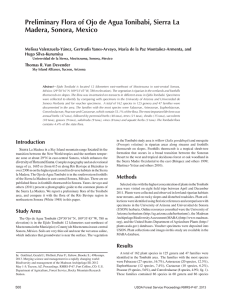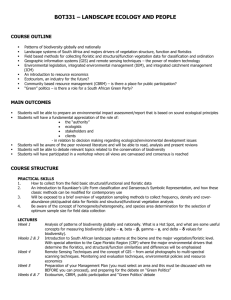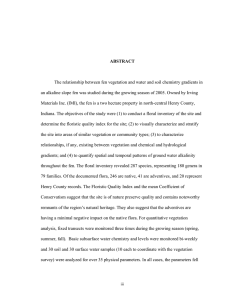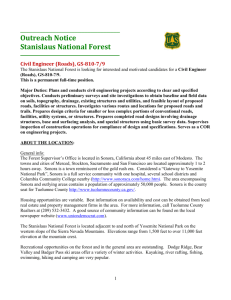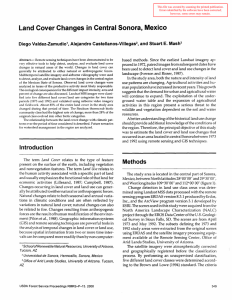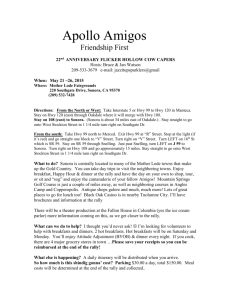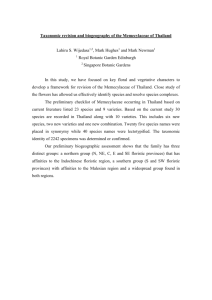Floristic Analysis of Heterogeneous Landscape Patches in
advertisement
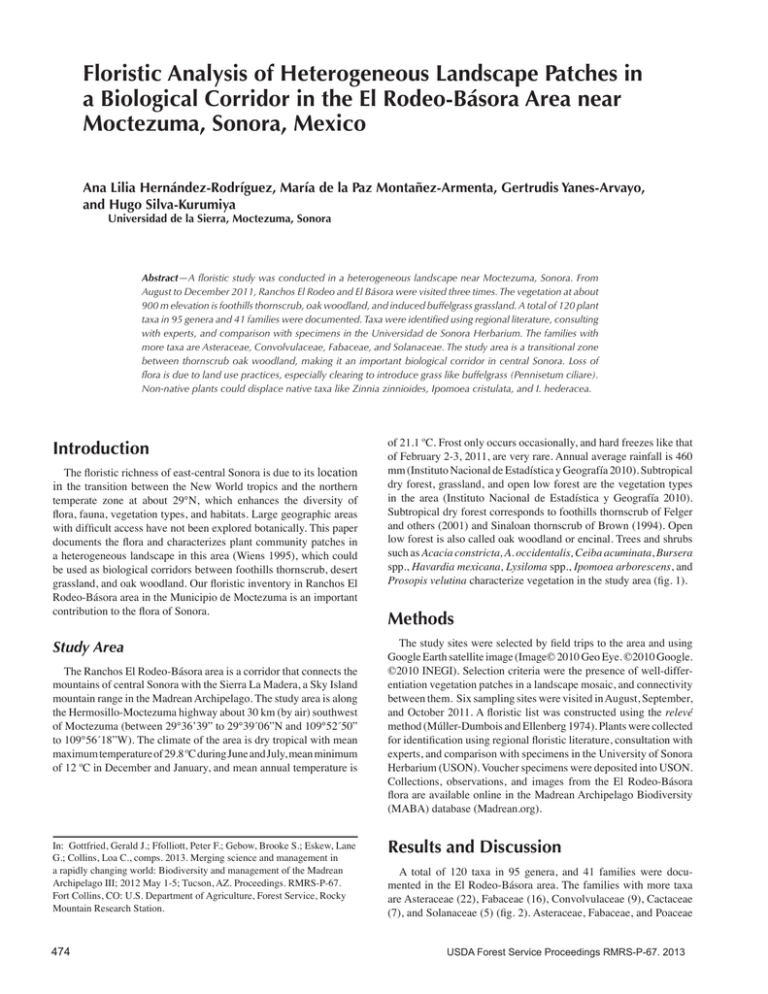
Floristic Analysis of Heterogeneous Landscape Patches in a Biological Corridor in the El Rodeo-Básora Area near Moctezuma, Sonora, Mexico Ana Lilia Hernández-Rodríguez, María de la Paz Montañez-Armenta, Gertrudis Yanes-Arvayo, and Hugo Silva-Kurumiya Universidad de la Sierra, Moctezuma, Sonora Abstract—A floristic study was conducted in a heterogeneous landscape near Moctezuma, Sonora. From August to December 2011, Ranchos El Rodeo and El Básora were visited three times. The vegetation at about 900 m elevation is foothills thornscrub, oak woodland, and induced buffelgrass grassland. A total of 120 plant taxa in 95 genera and 41 families were documented. Taxa were identified using regional literature, consulting with experts, and comparison with specimens in the Universidad de Sonora Herbarium. The families with more taxa are Asteraceae, Convolvulaceae, Fabaceae, and Solanaceae. The study area is a transitional zone between thornscrub oak woodland, making it an important biological corridor in central Sonora. Loss of flora is due to land use practices, especially clearing to introduce grass like buffelgrass (Pennisetum ciliare). Non-native plants could displace native taxa like Zinnia zinnioides, Ipomoea cristulata, and I. hederacea. Introduction The floristic richness of east-central Sonora is due to its location in the transition between the New World tropics and the northern temperate zone at about 29°N, which enhances the diversity of flora, fauna, vegetation types, and habitats. Large geographic areas with difficult access have not been explored botanically. This paper documents the flora and characterizes plant community patches in a heterogeneous landscape in this area (Wiens 1995), which could be used as biological corridors between foothills thornscrub, desert grassland, and oak woodland. Our floristic inventory in Ranchos El Rodeo-Básora area in the Municipio de Moctezuma is an important contribution to the flora of Sonora. Study Area The Ranchos El Rodeo-Básora area is a corridor that connects the mountains of central Sonora with the Sierra La Madera, a Sky Island mountain range in the Madrean Archipelago. The study area is along the Hermosillo-Moctezuma highway about 30 km (by air) southwest of Moctezuma (between 29°36’39” to 29°39´06”N and 109°52´50” to 109°56´18”W). The climate of the area is dry tropical with mean maximum temperature of 29.8 ºC during June and July, mean minimum of 12 ºC in December and January, and mean annual temperature is In: Gottfried, Gerald J.; Ffolliott, Peter F.; Gebow, Brooke S.; Eskew, Lane G.; Collins, Loa C., comps. 2013. Merging science and management in a rapidly changing world: Biodiversity and management of the Madrean Archipelago III; 2012 May 1-5; Tucson, AZ. Proceedings. RMRS-P-67. Fort Collins, CO: U.S. Department of Agriculture, Forest Service, Rocky Mountain Research Station. 474 of 21.1 ºC. Frost only occurs occasionally, and hard freezes like that of February 2-3, 2011, are very rare. Annual average rainfall is 460 mm (Instituto Nacional de Estadística y Geografía 2010). Subtropical dry forest, grassland, and open low forest are the vegetation types in the area (Instituto Nacional de Estadística y Geografía 2010). Subtropical dry forest corresponds to foothills thornscrub of Felger and others (2001) and Sinaloan thornscrub of Brown (1994). Open low forest is also called oak woodland or encinal. Trees and shrubs such as Acacia constricta, A. occidentalis, Ceiba acuminata, Bursera spp., Havardia mexicana, Lysiloma spp., Ipomoea arborescens, and Prosopis velutina characterize vegetation in the study area (fig. 1). Methods The study sites were selected by field trips to the area and using Google Earth satellite image (Image© 2010 Geo Eye. ©2010 Google. ©2010 INEGI). Selection criteria were the presence of well-differentiation vegetation patches in a landscape mosaic, and connectivity between them. Six sampling sites were visited in August, September, and October 2011. A floristic list was constructed using the relevé method (Múller-Dumbois and Ellenberg 1974). Plants were collected for identification using regional floristic literature, consultation with experts, and comparison with specimens in the University of Sonora Herbarium (USON). Voucher specimens were deposited into USON. Collections, observations, and images from the El Rodeo-Básora flora are available online in the Madrean Archipelago Biodiversity (MABA) database (Madrean.org). Results and Discussion A total of 120 taxa in 95 genera, and 41 families were documented in the El Rodeo-Básora area. The families with more taxa are Asteraceae (22), Fabaceae (16), Convolvulaceae (9), Cactaceae (7), and Solanaceae (5) (fig. 2). Asteraceae, Fabaceae, and Poaceae USDA Forest Service Proceedings RMRS-P-67. 2013 Floristic Analysis of Heterogeneous Landscape Patches in a Biological Corridor . . . Hernández-Rodríguez, and others Figure 1—Study area and vegetation. Figure 2—Dominant families in the El Rodeo-Básora area. USDA Forest Service Proceedings RMRS-P-67. 2013 are the most speciose families in floras in Sonora (Van Devender and others 2010). Life forms of the taxa were classified according to Whittaker (1975) and (Krebs 1972): (a) trees—woody plants greater than three m tall; (b) shrubs—short, woody plant less than three m tall; (c) herbaceous—not woody plant above ground; (d) vines—woody vines or herbaceous vines; (e) epiphyte—plants that grow on other plants, but are not parasitic. Herbs with 62 taxa are the most common life form (fig. 3). The physical structure of the vegetation is defined by trees, shrubs, and large succulents (especially organpipe cactus [Stenocereus thurberi]). Trees with 17 taxa are much more diverse than in desert grassland, but only represent 14.2% of the flora. Some common plants in the transition between foothills thornscrub and oak woodland include Ceiba acuminata, Fouquieria macdougalli, F. splendens, Ipomoea arborescens, Lysiloma divaricatum, Parkinsonia praecox, Prosopis velutina, Quercus chihuahuensis, Q. viminea, and Sabal uresana. Floristic richness is threatened by cattle ranching and the introduction of exotic forage plants. Four species in the El Rodeo-Básora flora have federal protection status in Mexico according to the NOM-059-SEMARNAT-2010 (DOF 2010). Agave angustifolia (Agavaceae) has a status of Amenazada (= Threatened), while Amoreuxia palmatifida (Bixaceae), Crusea hispida (Rubiaceae), and Sabal uresana (Arecaeae) have special status. 475 Hernández-Rodríguez, and others Floristic Analysis of Heterogeneous Landscape Patches in a Biological Corridor . . . We thank Thomas R. Van Devender and Ana Lilia Reina-Guerrero for help in identifying plants and a careful review of the manuscript. References Figure 3—Dominant life forms of taxa in the El Rodeo-Básora area. We conclude that the El Rodeo-Básora area is of special interest and conservation concern because of its mosaic of foothills thornscrub, desert grassland, and oak woodland, its floristic diversity, its role as a biological corridor connecting central Sonora landscapes to the Sky Island region, and the presence of four federally protected species. Acknowledgments Diario Oficial de la Federación. 30 de octubre de 2010. Page 28. (Segunda Sección)1. NORMA Oficial Mexicana NOM-059-SEMARNAT-2010, Protección ambiental-Especies nativas de México de flora y fauna silvestresCategorías de riesgo y especificaciones para su inclusión, exclusión o cambio-Lista de especies en riesgo. Brown, David E. 1994. Biotic communities of the southwestern United States and northwestern Mexico. Salt Lake City: University of Utah. 342 p. Felger, Richard; Johnson, Matthew B.; Wilson, Michael F. 2001. The trees of Sonora, Mexico. New York: Oxford University Press. 391 p. Instituto Nacional de Estadística y Geografía. Consultado el 26 de octubre de 2011. En http: www.inegi.gob.mx 2010. Krebs, J. Charles. 1972. Ecologìa. Estudio de la Distribución y la Abundancia. 2nd. Edición. México: Editorial OXFORD. pp. 452-455. Mueller–Dombois, D.; Ellenberg, H. 1974. Aims and methods of vegetation ecology. New York: John Wiley. 547 p. Van Devender, Thomas. R.; Felger, Richard F.; Fishbein, Mark; [and others]. 2010. Biodiversidad de las plantas vasculares. Pp. 229-262 in Molina-Freaner, Francisco; and Van Devender, Thomas R. eds. Diversidad Biológica de Sonora, Hermosillo: Universidad Nacional Autónoma de México. http://www.skyislandalliance.org/Sonoran%20vascular%20 plants-VanDevender%20et%20al.2010.pdf Wiens, John A. 1994. Habitat fragmentation: Island v landscape perspectives on bird conservation. Ibis. 37: 97-104. We thank J. Jesús Sánchez-Escalante at the Universidad de Sonora for help identifying plants and putting voucher specimens into USON. The content of this paper reflects the views of the authors, who are responsible for the facts and accuracy of the information presented herein. 476 USDA Forest Service Proceedings RMRS-P-67. 2013



